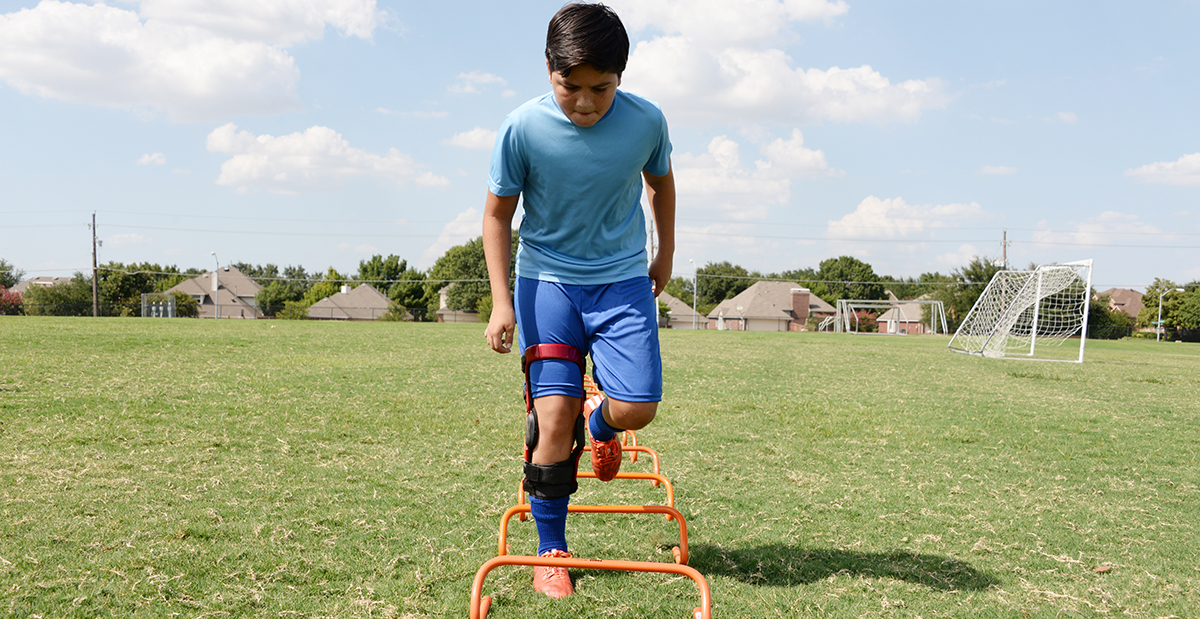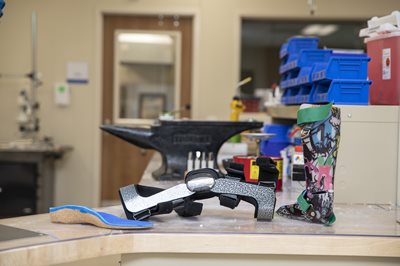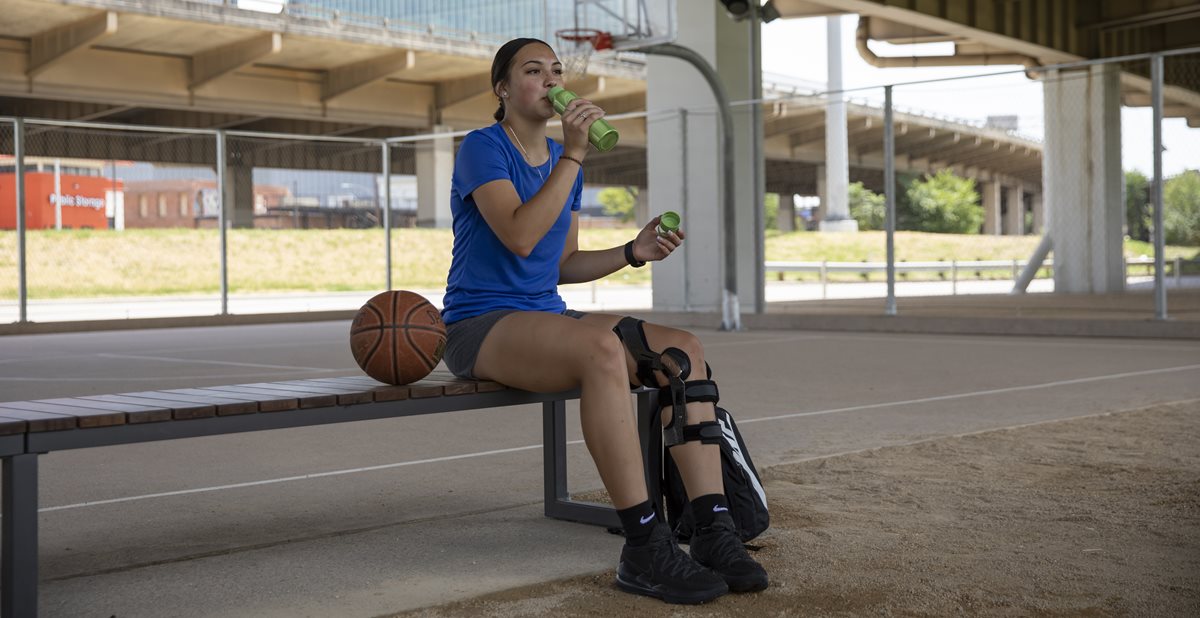
Apr 21, 2021 / Sports Medicine
To Brace or Not to Brace? And Other Bracing FAQ's in Pediatric Sports Medicine
The opinions about bracing joints to address or prevent injuries in youth sports are constantly evolving. The objective comparison of one brace to the next is challenging because of the many variables associated with the conversation. Age, type of brace, joint flexibility, sport, level of competition and many other factors come into play. Additionally, there are hundreds of braces on the market that promise to protect a joint or offer relief from an injury.
What is an orthotic?
An orthotic is the medical term for braces and splints that provide support or protection to muscles, joints or bones. Our sports medicine team provides splints and braces after an injury when appropriate. Athletic trainer Josh Stevens, A.T.C., L.A.T., says, “Most sport-related injuries do not need a cast, but braces offer immobilization and provide protection of the joint while it is healing.” Since braces are removable, they have a lower risk of complications than a cast and can be an appropriate treatment for a fracture.
Braces and orthotics range from off-the-shelf, or ready to wear, to custom designed and fabricated for a single patient. We asked Scottish Rite orthotist, Kelsey Thompson, C.P.O., to respond to common questions from patients.
Off-the-Shelf
Some braces are easily found online and in sporting goods stores and pharmacies. These offer a range of benefits. These may include compression to reduce swelling in a new injury or stability to prevent movement in a specific direction. These do not require the orthotist to participate in selection, fit or adjustments.
Should I wear an ankle brace to play basketball?
There’s not one answer for everyone. There isn’t evidence to show that an ankle brace is going to prevent an injury. For athletes that have ankle injuries or ankle instability frequently, a comfortable, well-fitting brace or properly applied ankle tape may be helpful.
What is a patellar tendon strap?
In older teens, a condition called patellar tendonitis may cause pain in the front of the knee. The strap is placed across the middle of the patellar tendon, the short, tight band between the patella (kneecap) and the lower leg bone. The pressure on the middle of the tendon changes the intensity and direction of the tension (stretching) that causes the pain with movement.
Semi-Custom Braces and Orthotics
In some cases, an orthotist may be involved in measurement, selection or modifications to these braces.
Are all shoe inserts the same?
Shoe inserts are often recommended to help reduce foot pain from flat feet or high arches. The purpose of a shoe insert, also called a foot orthosis, is to provide stability to a flexible foot or support to a rigid (inflexible) foot. Since every foot is unique, an athlete may try several inserts before finding one that works.
Proper foot positioning will help an athlete by providing a solid foundation for movement. The foot is considered the beginning of the kinetic chain, a series of mobile and stable joints and muscles working together to produce movement and control. An orthotist evaluates the mobility and function of the foot and ankle to design a custom foot orthotic when off-the-shelf options do not provide the support needed.
Why do some football players wear a knee brace?
You might notice that football linemen often wear a brace on each knee. These hinged braces have been shown to protect the knee joint from stresses to a ligament on the inside of the knee, the medial collateral ligament. This ligament may not withstand the forces of tackles in these strong, and typically, larger players. These braces are made in many sizes and require a good fit and proper application to be effective.
Custom Braces
An orthotist participates in the measurement and recommendation for these devices. Some are even fabricated from raw materials for the patient in our orthotics and prosthetics lab.
After an anterior cruciate ligament (ACL) reconstruction, will I have to wear a brace to play sports?
Every case is unique. Some athletes do need a custom or semi-custom functional knee brace to return to contact or sports that require a lot of change in direction. Our physical therapy team provides functional and sport-specific rehabilitation to enhance intrinsic protection (muscle and nerve control and power inside the body) to reduce dependence or eliminate the need for an external brace. Depending on the patient’s maturity and extent of injury determines how long the brace needs to be worn. The goal of the brace is to prevent re-injury to the ligament that was surgically repaired.
Are there injuries that require long-term permanent custom braces?
Yes, in cases like Scottish Rite MVP Kalen, a significant joint injury can cause nerve damage. When a nerve is no longer able to “talk to” a muscle, the muscle will no longer do its job. For Kalen, a traumatic knee injury left him unable to lift his foot putting him at risk of tripping when walking, running and playing football. The orthotist fabricated an ankle foot orthosis (AFO) that fit inside his normal shoes and could also be worn with his custom knee brace. The AFO was flexible enough to allow running but prevented the footdrop that might cause tripping.
What advice do you have for young athletes?
If I had to pick one piece of advice, I would remind them that flexibility and stretching are so important. Here at our Frisco campus, we see a lot of patients with flat feet or low back pain and most of them would benefit from regular stretching to increase their flexibility. Look for sports and activities that promote flexibility. Choose a supportive shoe with an off-the-shelf insole is also a great option to add to prevent unwanted aches, pains and injuries. Kids grow very quickly and without proper stretching, they can get tight. Encourage them to actively stretch or even try sitting on the floor with their legs straight when playing a video game.
Learn more more about pediatric sports medicine.
What is an orthotic?
An orthotic is the medical term for braces and splints that provide support or protection to muscles, joints or bones. Our sports medicine team provides splints and braces after an injury when appropriate. Athletic trainer Josh Stevens, A.T.C., L.A.T., says, “Most sport-related injuries do not need a cast, but braces offer immobilization and provide protection of the joint while it is healing.” Since braces are removable, they have a lower risk of complications than a cast and can be an appropriate treatment for a fracture.
Braces and orthotics range from off-the-shelf, or ready to wear, to custom designed and fabricated for a single patient. We asked Scottish Rite orthotist, Kelsey Thompson, C.P.O., to respond to common questions from patients.
Off-the-Shelf
Some braces are easily found online and in sporting goods stores and pharmacies. These offer a range of benefits. These may include compression to reduce swelling in a new injury or stability to prevent movement in a specific direction. These do not require the orthotist to participate in selection, fit or adjustments.
Should I wear an ankle brace to play basketball?
There’s not one answer for everyone. There isn’t evidence to show that an ankle brace is going to prevent an injury. For athletes that have ankle injuries or ankle instability frequently, a comfortable, well-fitting brace or properly applied ankle tape may be helpful.
What is a patellar tendon strap?
In older teens, a condition called patellar tendonitis may cause pain in the front of the knee. The strap is placed across the middle of the patellar tendon, the short, tight band between the patella (kneecap) and the lower leg bone. The pressure on the middle of the tendon changes the intensity and direction of the tension (stretching) that causes the pain with movement.
Semi-Custom Braces and Orthotics
In some cases, an orthotist may be involved in measurement, selection or modifications to these braces.
Are all shoe inserts the same?
Shoe inserts are often recommended to help reduce foot pain from flat feet or high arches. The purpose of a shoe insert, also called a foot orthosis, is to provide stability to a flexible foot or support to a rigid (inflexible) foot. Since every foot is unique, an athlete may try several inserts before finding one that works.
Proper foot positioning will help an athlete by providing a solid foundation for movement. The foot is considered the beginning of the kinetic chain, a series of mobile and stable joints and muscles working together to produce movement and control. An orthotist evaluates the mobility and function of the foot and ankle to design a custom foot orthotic when off-the-shelf options do not provide the support needed.
Why do some football players wear a knee brace?
You might notice that football linemen often wear a brace on each knee. These hinged braces have been shown to protect the knee joint from stresses to a ligament on the inside of the knee, the medial collateral ligament. This ligament may not withstand the forces of tackles in these strong, and typically, larger players. These braces are made in many sizes and require a good fit and proper application to be effective.
Custom Braces
An orthotist participates in the measurement and recommendation for these devices. Some are even fabricated from raw materials for the patient in our orthotics and prosthetics lab.

After an anterior cruciate ligament (ACL) reconstruction, will I have to wear a brace to play sports?
Every case is unique. Some athletes do need a custom or semi-custom functional knee brace to return to contact or sports that require a lot of change in direction. Our physical therapy team provides functional and sport-specific rehabilitation to enhance intrinsic protection (muscle and nerve control and power inside the body) to reduce dependence or eliminate the need for an external brace. Depending on the patient’s maturity and extent of injury determines how long the brace needs to be worn. The goal of the brace is to prevent re-injury to the ligament that was surgically repaired.
Are there injuries that require long-term permanent custom braces?
Yes, in cases like Scottish Rite MVP Kalen, a significant joint injury can cause nerve damage. When a nerve is no longer able to “talk to” a muscle, the muscle will no longer do its job. For Kalen, a traumatic knee injury left him unable to lift his foot putting him at risk of tripping when walking, running and playing football. The orthotist fabricated an ankle foot orthosis (AFO) that fit inside his normal shoes and could also be worn with his custom knee brace. The AFO was flexible enough to allow running but prevented the footdrop that might cause tripping.
What advice do you have for young athletes?
If I had to pick one piece of advice, I would remind them that flexibility and stretching are so important. Here at our Frisco campus, we see a lot of patients with flat feet or low back pain and most of them would benefit from regular stretching to increase their flexibility. Look for sports and activities that promote flexibility. Choose a supportive shoe with an off-the-shelf insole is also a great option to add to prevent unwanted aches, pains and injuries. Kids grow very quickly and without proper stretching, they can get tight. Encourage them to actively stretch or even try sitting on the floor with their legs straight when playing a video game.
Learn more more about pediatric sports medicine.



